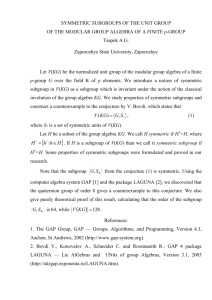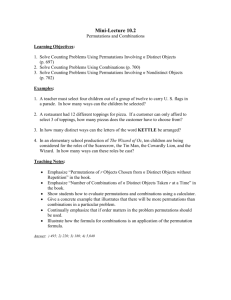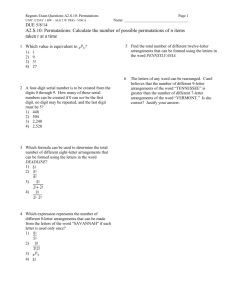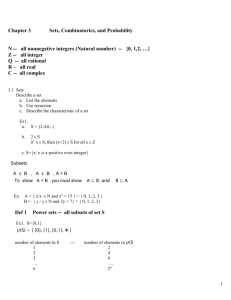The `odd` number six
advertisement
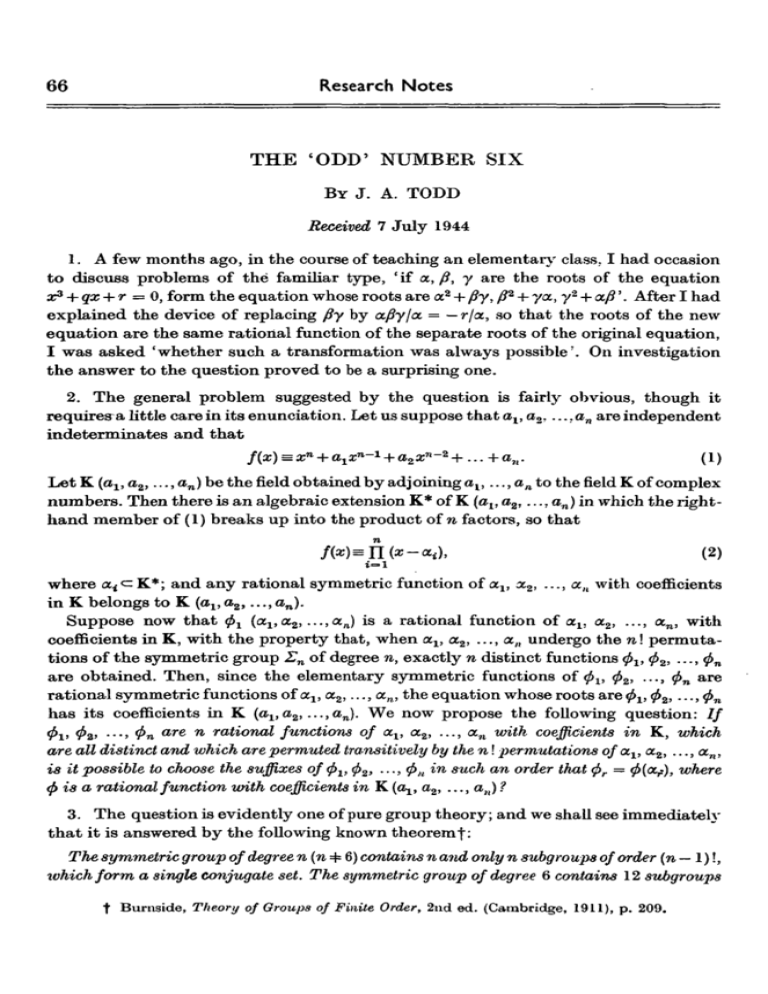
66
Research Notes
THE 'ODD' NUMBER SIX
BY J. A. TODD
Received 7 July 1944
1. A few months ago, in the course of teaching an elementary class. I had occasion
to discuss problems of the familiar type, ' if a, /?, y are the roots of the equation
x3 + qx + r = 0, form the equation whose roots are a2+fly, /?2 + ya, y'2 + acft'. After I had
explained the device of replacing fly by afiyja. = — r/a, so that the roots of the new
equation are the same rational function of the separate roots of the original equation,
I was asked 'whether such a transformation was always possible'. On investigation
the answer to the question proved to be a surprising one.
2. The general problem suggested by the question is fairly obvious, though it
requires a little care in its enunciation. Let us suppose that ava2, ....an are independent
indeterminates and that
*+...+an.
(1)
Let K (ax, a2,..., an) be thefieldobtained by adjoining av ..., an to thefieldK of complex
numbers. Then there is an algebraic extension K* of K (ava2,..., a.n) in which the righthand member of (1) breaks up into the product of n factors, so that
/(*)=n(*-Oi),
(2)
i=l
where a 4 c K * ; and any rational symmetric function of alt oc2, ..., an with coefficients
in K belongs to K (a1; o 2 ,..., a n ).
Suppose now that 0X (altoc2,...,an) is a rational function of av ct2, ..., <xn, with
coefficients in K, with the property that, when ctv a2, ..., a,, undergo the n\ permutations of the symmetric group En of degree n, exactly n distinct functions <f>lt (j>2, ...,<f>n
are obtained. Then, since the elementary symmetric functions of tf>v <j>2, ..., <f>n are
rational symmetric functions of a1( a 2 ,..., an, the equation whose roots are$ x , <f>2, ...,^>n
has its coefficients in K (ax,a2, ...,an). We now propose the following question: If
4>\i $2' •••> 0n are n rational functions of ocv <x2, ..., txn with coefficients in K, which
are all distinct and which are permuted transitively by the n! permutations of <XX,OL2, ...,an,
is it possible to choose the suffixes of $lt (j>2, ...,<f>nin such an order that (j>r = <j>(<Xf), where
<fr is a rational function with coefficients in K (a^, a2, ..., an) ?
3. The question is evidently one of pure group theory; and we shall see immediately
that it is answered by the following known theoremf:
The symmetric group of degree n (n + 6) contains n and only n subgroups of order (n — 1)!,
ivhich form a single conjugate set. The symmetric group of degree 6 contains 12 subgroups
t Bumside, Theory of Groups of Finite Order, 2nd ed. (Cambridge, 1911), p. 209.
Research Notes
67
of order 5!, lohich are simply isomorphic with one other and form two conjugate sets of
6 each.
To see that this theorem answers the question just raised, we observe that those
permutations of ax, a2, ..., an which keep <f>xfixedform a subgroup of index n in En,
so that the order of this subgroup is (n — 1)!. Hence, if n =)= 6, this subgroup must consist
of the set of permutations of alt a 2 ,..., an which keep one symbol (say a.x)fixed.Therefore 0X is a symmetric function of a2, ..., <xn, and can be expressed rationally in terms of
the elementary symmetric functions of a2, ..., a n , the coefficients of these symmetric
functions being in the field K(a1). But the elementary symmetric functions of a 2 ,..., a n
can be expressed rationally in terms of o1, a2, ..., an and a r Hence <j>x is a rational function of tx± with coefficients in K (av a2, ...,an). On the other hand, if n = 6 this need not
be the case, since the permutations of ax, a2, ..., a n which leave <j>t invariant may form
a subgroup belonging to the second conjugate set (the first set consisting of the subgroups keeping one of the a t unchanged).
4. The interest of this rather trivial theorem, of course, centres entirely around
the anomalous case n = 6; and this anomaly arises from the exceptional property of
the symmetric group of degree 6 implied by the theorem quoted in the last section.
It may, therefore, not be amiss to point out that this theorem is at bottom the explanation of another curious phenomenon associated with the number 6, which arises
in some well-known geometrical configurations. This is the fact that the fifteen pairs
ij formed by two out of six symbols 1, 2, .... 6 can be arranged in fifteen ways in sets
(such ns 12, 34, 56) of three pairs containing between them all six symbols, and that
these fifteen sets can be arranged in six ways in sets of five, so that each set of five
contains all the fifteen pairs.f These sets aref
I
II
III
IV
V
VI
(14, 25, 36) (16, 24, 35) (13, 26, 45) (12, 34, 56) (15, 23, 46);
(14, 25, 36) (15, 26, 34) (12, 35, 46) (16, 23, 45) (J3, 24, 56);
(16, 24, 35) (15, 26, 34) (14, 23, 56) (13, 25, 46) (12, 36, 45);
(13, 26, 45) (12, 35, 46) (14, 23, 56) (15, 24, 36) (16, 25, 34);
(12, 34, 56) (16, 23, 45) (13, 25, 46) (15, 24, 36) (14, 26, 35);
(15, 23, 46) (13, 24, 56) (12, 36, 45) (16, 25, 34) (14, 26, 35).
The point to be observed is that the 6! permutations of the symbols 1, 2, ..., 6 effect
the 6! permutations of the sets I, II, ..., VI. But those permutations which keep 1
unaltered form a subgroup which is transitive on the sets I, II, ..., VI, since the two
permutations (23), (24) effect the respective permutations (I, VI) (II, V) (III, IV) and
(1,111) (II, VI) (IV, V). Thus we have a representation of the two conjugate sets of
subgroups of index 6 in Z6, one such set consisting of the subgroups keeping one of the
t Sylvester, Collected Papers, 1, p. 92. See, e.g., Baker, Principles of Geometry, 2 (Cambridge,
1922), p. 221, and some remarks by Room, Geometry of Determinantal Loci (Cambridge, 1938),
p. 301.
% Baker, loc. cit.
5-2
68
Research Notes
symbols 1, 2, ..., 6 unchanged, and the other consisting of the subgroups keeping one
of the sets I, II, ..., VI unchanged.
We may remark, finally, that this arrangement of triads of pairs of symbols enables
us to construct six rational functions of alt a2, ..., a6 which are permuted among themselves transitively by the permutations of £6 but cannot be expressed as rational
functions of a single one of the a's. Thus we may take
(a x a 2 + 1x30,1 + a 5 a 6 ) (a x a s + a 2 a 3 + a 4 a 6 )
and <j>n, ..., <f>vx as the similar expressions obtained from II, ..., VI. The construction,
in terms of av ..., ae, of the equation satisfied by <j)1} ..., 0 V I appears formidable!
TRINITY COLLEGE
CAMBRIDGE
EXPANSIONS OF COORDINATES OF POINTS OF A
PLANE CURVE IN TERMS OF s OR xjj
BY H. T. H. PIAGGIO
Received 18 July 1944
If O is an ordinary point of a plane curve and the tangent and inward normal at 0 are
taken as axes, then, under certain conditions, the coordinates x and y of a neighbouring
point P on the curve can be expanded in powers of s, the arc OP, or of xjr, the anglebetween the tangents at 0 and P. Lamb(3) gives these expansions as far as the terms in
*4 and ijr3. Dockeray(i) goes as far as the terms in s6, but there seem to be three errors
in his results. No one, I believe, has given the general terms. I obtain these for both
pairs of expansions. Fowler(2) gives the term in s2"""1"1 in the expansion of x in the special
case where, owing to the vanishing of the curvature and of its first r — 2 derivatives,
the expansion of y begins with the term in sr+1. I shall give reasons for disagreeing with
this result.
Expansions in terms of ifr. Use the suffix r to denote the result of differentiating r
times with respect to ft and then putting t]s = 0. Since
d(x + iy) _ ds d{x+iy)
dn+1(x + iy)
so
x
n+l + iyn+l = 2 L I ikPn-k
k=0\K/
Hence
and
xn+1 = pn^( o)pn^+ ... + (-)'(j,
2/n+i = nPn-i •


